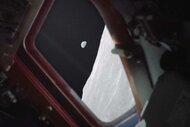Create a free profile to get unlimited access to exclusive videos, sweepstakes, and more!
Earth Has Had a Second Moon (Sort Of) for the Last Few Thousand Years
Gives new meaning to "one small step."
In the 1960s, humanity embarked upon the greatest adventure in the history of our species when human beings left the confines of our planet on a journey to another world, for the first time. First to the Moon (streaming on Peacock!) tells the story of Apollo 8, the first crewed mission to leave low-Earth orbit and travel to the Moon. It carried astronauts Frank Borman, James Lovell, and William Anders as they orbited the Moon a total of 10 times before returning home. They were followed by nine additional Apollo missions, all of which were successful save for the now-infamous Apollo 13. Even when NASA fails, at least it’s exciting!
Astronomers Discover New Quasi-moon
Now, astronomers have discovered another moon (sort of) orbiting the Earth (sort of). The asteroid 2023 FW13 was recently discovered, trailing along beside the Earth in a complicated semi-orbit. Rather than orbiting the Earth directly, like the Moon does, 2023 FW13 orbits the Sun, but its complicated orbit causes it to also circle the Earth. That keeps 2023 FW13 in roughly the same area as us, even though it isn’t orbiting the Earth directly.
RELATED: A Near-Earth Asteroid May Actually Be a Chunk of the Moon Blasted Into Orbit!
Unfortunately, 2023 FW13 isn’t the sort of moon we could send explorers to. It is considerably smaller and farther away than our more famous Moon. The object is estimated to be only 50 feet (15 meters) in diameter and remains about 9 million miles away at its closest approach to the Earth. That’s about 35 times farther than the Moon’s quarter-mile distance, but it’s still pretty close, cosmically speaking.
The quasi-moon was first observed by researchers at the Pan-STARSS observatory on Haleakalā in Hawaii, in March 2023. The discovery was later confirmed by the Canada-France-Hawaii Telescope and two observatories in Arizona. It is now listed in the International Astronomical Union’s Minor Planet Center registry.
While the object is still being studied and our understanding of it will likely change with new and better data, current estimates suggest 2023 FW13 entered its current orbit alongside the Earth at least 2,000 years ago. Simulations based on preliminary orbital calculations predict it will remain in the neighborhood for at least another 1,700 years.
RELATED: Meet the Artemis II astronauts, set to take NASA's historic 2024 return trip around the Moon
We’ll be sad to see it go when its time in our system comes to an end, but there’s a good chance we’ll collect or discover additional quasi-moons in the interim. In fact, 2023 FW13 isn’t alone in its class. In 2016, astronomers discovered another quasi-moon, known as Kamo'oalewa. It’s a litter larger than 2023 FW13 (which needs a cooler name, stat), between 40 and 100 meters (131 to 328 feet) across and it gets within about 5 million kilometers (3.1 million miles) of us. Analysis of the object has revealed Moon-like silicates, suggesting it may actually be a splintered fragment of the Moon itself.
Astronauts likely won’t be visiting any of our quasi-satellites any time soon, but they are headed back to the actual Moon in short order, and we can’t wait!
In the meantime, brush up on your Apollo history with First to the Moon, streaming now on Peacock!






























